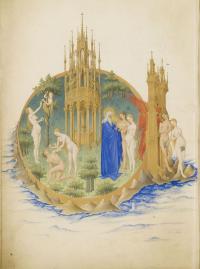
A friend recently drew my attention to a newly reposted essay from Answers in Genesis’s Ken Ham, asking, “Where was the Garden of Eden located?” No answers, alas: according to Ham, Noah’s Flood so transformed the geography of the earth that there’s no telling where the Temptation of Eve and the Fall of Adam occurred. Faced with the fact that the Bible identifies two of the rivers of Eden as the Tigris and the Euphrates, Ham asserts—without evidence—that the present rivers were named after antediluvian rivers, just as the Thames in Connecticut is named after the Thames in England. “To insist that the Garden was located in the area around the present Tigris and Euphrates Rivers is to deny the catastrophic effects of the global Flood of Noah’s day, and to allow for death before sin,” he concludes. I’m not sure how “death before sin” is supposed to be relevant: according to Answers in Genesis’s chronology, sin and death enter the world together with the Fall, over fifteen hundred years before the Flood.
Anyhow, I suspect that the first time I encountered the idea of the search for the historical Eden was when I read Lytton Strachey’s Eminent Victorians (1918), which was devoted to puncturing the reputations of four Victorian heroes. Among them was General Charles Gordon, famous for leading the Ever-Victorious Army in China, serving as the Governor-General of the Sudan, and ultimately dying at the hands of the Mahdi’s army in the siege of Khartoum. What Strachey chose to open his essay with, however, was Gordon’s search for the historical Eden: “During the year 1883 a solitary English gentleman was to be seen, wandering, with a thick book under his arm, in the neighbourhood of Jerusalem. … To the friendly inquirer, he would explain, in a low, soft, and very distinct voice, that he was engaged in elucidating four questions—the site of the crucifixion, the line of division between the tribes of Benjamin and Judah, the identification of Gibeon, and the position of the Garden of Eden.”
A brilliant essayist but not the most accurate of biographers, Strachey was wrong. For by 1882, Gordon had already resolved the question of the position of the Garden of Eden to his own satisfaction: the island of Praslin in the Indian Ocean. Having assumed the command of a detachment of Royal Engineers in the Seychelles in 1881, Gordon noted with interest what a biographer describes delicately as “the remarkable similarity between the ripe fruit of the coco de mer, a gigantic palm tree, and Eve’s pudenda. This, then, was the Tree of Knowledge of Good and Evil. The Breadfruit, with its equally striking resemblance to Adam’s organ, was clearly The Tree of Life. ... To clinch the case, he found on Praslin a small serpent.” It’s astonishing that Brook Wilensky-Lanford, whose delightful Paradise Lust: Searching for the Garden of Eden I reviewed in 2012 for Skeptic, didn’t spend more time with Gordon—but she found plenty of people with funny ideas about Eden to discuss regardless. Including those at Answers in Genesis.
How funny? Early in the book, Wilensky-Lanford summarizes the results: in the nineteenth and twentieth centuries alone, “the Garden of Eden had been found in Iraq, Turkey, Sri Lanka, Mongolia, the Seychelles, Florida, California, Missouri, and Ohio; at the North Pole; under the Mediterranean near Crete; in Sweden, the Persian Gulf, and Egypt.” And she confined herself to the less wacky ideas here. As I noted in my review, she omitted any mention of “the eccentric Irish peer and ufologist Brinsley Le Poer Trench, who in his 1960 book The Sky People endorsed the idea that the rivers of Genesis must be canals, but astutely noted, ‘If such a canal system, as described in Genesis[,] even existed on this earth, there is no trace nor record of it.’ But there is a place, he continued, that abounds with canals and thus must have been the site of Eden: Mars.” In refusing to identify, or even speculate about, the actual location of the Garden of Eden, then, Answers in Genesis is the outlier.
As far as I can tell, Ham’s strategy of deflecting the question of the location of the Garden of Eden originated in the pioneering document of modern flood geology, John C. Whitcomb and Henry M. Morris’s The Genesis Flood (1961), which suggests, “The fact that Genesis 2:14 mentions the Tigris (Hiddekel) and the Euphrates rivers is certainly not conclusive evidence to the contrary, for these and other geographical names could have been perpetuated by Noah’s family into ‘the new world’ even as happens in modern times.” Not that there’s any biblical verse in which Noah or his offspring are reported as naming features in the landscape so drastically reconfigured by the flood after any antediluvian landmarks. There’s something ironic here, of course: flood geologists are so eager to avoid what they regard as the unsupported speculation of the overwhelming consensus of mainstream geology that they embrace what really is unsupported speculation about geographical onomastic practice in the ancient Near East.

